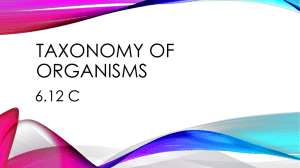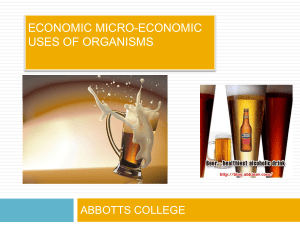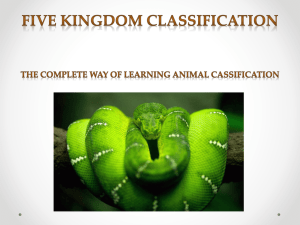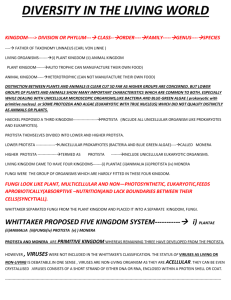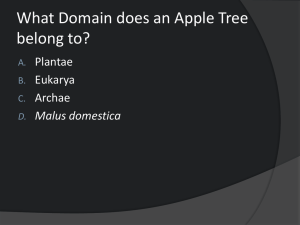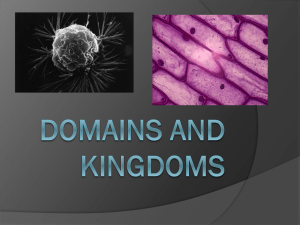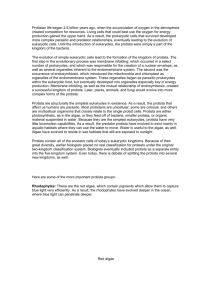Archaea, Bacteria, & Eukarya
advertisement
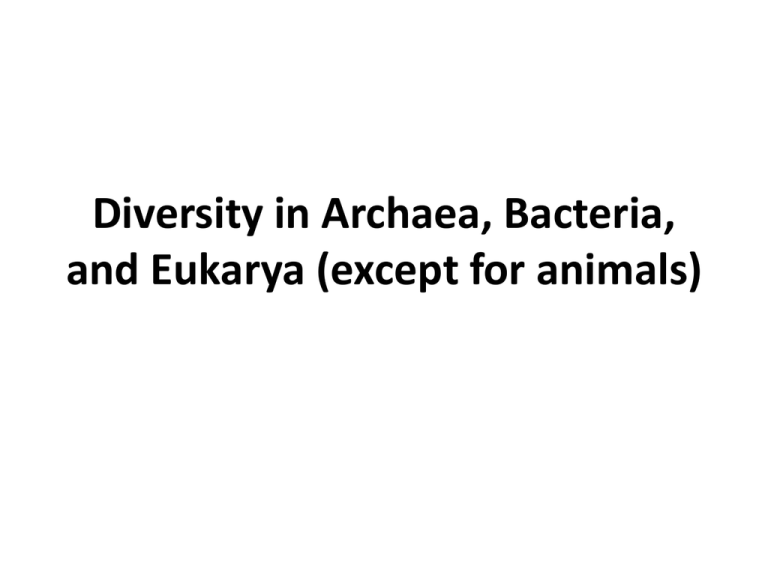
Diversity in Archaea, Bacteria, and Eukarya (except for animals) Introduction • Life developed on earth 3.1-3.8 billion years ago • The first living organisms were simple cells with little internal structures and primitive metabolism (prokaryotes) • All living species evolved from them. Introduction • There are between 8 and 20 million existing species. Less than 2 million have been named • Taxonomy = classification system • Linnaeus classification system based upon structural similarities between species. • Modern classification system based upon evolutionary relationships (determined by DNA sequencing). Classification categories • • • • • • • • domain kingdom - a group of related phyla phylum (plural = phyla) - a group of related classes. class - a group of related orders order - a group of related families family - a group of related genera genus (plural = genera) - a group of related species Species - a kind of living organism . All organisms who can potentially reproduce together under natural conditions and produce fertile offspring. Naming species • Binominal nomenclature (two names) • The scientific name of a species is formed by the genus name followed by species name Homo sapiens Canis familiaris 3 Domains 1. Bacteria – Includes blue-green algae 2. Archaea 3. Eukarya – The Eukarya are divided into 4 Kingdoms: Plants, Fungi, Animals and ?Protista? Biology by Krogh: The term protist is a label of convenience rather than a label that reflects evolutionary reality….It actually refers to many different evolutionary lines of organisms. Recent studies of protist DNA and ultrastructure has shown that the protists are far more diverse than had been previously thought. They probably should be classified in several kingdom-level taxa. We retain the word "protist" as a convenient term to mean "eukaryote that isn't a plant, animal, or fungus." University of California Berkeley Museum of Paleontology 2011 http://www.ucmp.berkeley.edu University of California Berkeley Museum of Paleontology 2011: The 12 kingdoms Domain Bacteria Domain Archaea Domain Eukarya Domains Bacteria & Archaea Kingdom ?Protista? Kingdom Plantae Kingdom Fungi Kingdom Animalia Cells Type Prokaryotic Eukaryotic Eukaryotic Eukaryotic Eukaryotic Number of Cells Unicellular or Colonial Unicellular or Colonial Multicellular Multicellular Multicellular Autotrophic or Autotrophic or Autotrophic Heterotrophic (Saprophytic) Heterotrophic (ingestion) Cell Wall (Chitin) No Cell Wall Type of Nutrition Heterotrophic Heterotrophic Cell Wall Cell Wall Cell Wall or No Cell Wall Cell Wall (Cellulose) Examples Bacteria & Blue-Green Bacteria (algae) Protozoa & some algae Seaweeds, Mushrooms, some algae, molds mosses, vascular plants Humans, fish, insects Cell Types: Prokaryotic: small, simple cells which lack a nucleus and other cell structures Eukaryotic cells contain a nucleus and internal structures Number of cells: • Unicellular-one celled organism • Multicellular-many cells that function as a unit. Individual cells do not survive on their own. • Colony- a group of cells which are attached to each other, but each cell could survive on its own. Type of Nutrition: • Autotrophic- an organism that make its own food, usually by photosynthesis. • Heterotrophic- an organism that does not make its own food, it consumes other organisms by either ingesting them or by decomposing them( saprophytes). Cell wall: • material secreted by the cell • external to the plasma membrane • Chemical composition varies by kingdom Domain Bacteria • • • • Bacteria, includes Cyanobacteria (Blue Green Algae). Prokaryotic organisms Unicellular or colonial Autotrophic (chemosynthesis or photosynthesis) or heterotrophic • Cell wall • Reproduce by cell division. Also have sexual recombination. • Bacteria decompose dead bodies and cause disease Examples of blue-green algae: Oscillatoria, Nostoc. Bacterial Shapes • Spherical (coccus) • rod-shaped (bacillus) • Spiral shaped (spirillus) Domain Archaea • (formerly Archaebacteria) • Prokaryotic • Some but not all live under extreme conditions • There are basic differences between the biochemistry of Archaea and Bacteria. Domain Eukarya Kingdom ?Protista? (very heterogeneous – not a real group)) • Eukaryotic cells • Unicellular and colonial organisms • Some do have a cell wall, some do not. 1. Plant-like protista • Autotrophic (photosynthesis): Euglena, Diatom. 2. Animal-like protista, called Protozoa. . Move to catch food: Amoeba-pseudopodia. Paramecium-cilia. 3. Fungus-like protista, saprophytes. Domain Eukarya Kingdom Fungi • • • • Multi-cellular, Eukaryotic cells Heterotrophic-decomposers Cell wall Hyphae - microscopic, branching filaments, which take food from the substrate • Mycelium – the whole group of hyphae • Several phyla of fungi: mushrooms, puffballs, rusts, bread mold, yeast, bracket fungus, ring worm Domain Eukarya Kingdom Plantae • • • • • Eukaryotic Multicellular Autotrophic Cell wall made of cellulose The plant kingdom is divided into many phyla, but there are three groups of phyla: 1. Algae (but are these in the kingdom Plantae, or their own kingdom(s)?) 2.Primitive Land Plants 3.Vascular Plants • Textbook: Red, brown, and green algae are in the Protista kingdom • Lab manual: Red, brown and green algae are in the Plant kingdom (see table on page 96) • UC Berkeley: Red, brown and green algae are in separate kingdoms. Algae (except for the blue-green algae) • • • • • • Filamentous body or flat, thin body Eukaryotic, cells with cell wall and chloroplasts Unicellular or colonial Photosynthetic Do not have vascular tissues Most live in water Examples of Algae 1. Green - fresh water, salt water, wet land: Spirogyra, Ulva 2. Red algae - deep ocean: Polysiphonia 3. Brown algae - ocean, coastal, huge seaweeds: (kelp) [Fucus]. Primitive Land Plants [Non-Vascular] • They do not have vascular tissues, so are small • They do have leaf-like, stem- like, and rootlike structures. • Examples: mosses, liverworts, and hornworts Vascular Plants or Tracheophytes • Have vascular tissue: – Xylem – transports water and minerals – Phloem - transports organic matter, mainly sugar • They have true roots, stems, and leaves • They are grouped by their reproductive structures. Vascular plants: 1. Seedless Plants – primitive leaves, roots and stems. -they make spores, do not make seeds -require water for reproduction -Examples: Fern, horsetail 2. Seed plants -produce seeds -produce pollen - do not require water for reproduction Vascular Seed Plants 1. Gymnosperms- naked seeds in cones *Do not have flowers or fruit *Examples: Cycads, Ginkgos, and Conifers 2. Angiosperms *Produce flowers [pollinated by wind, insects, birds, etc.] *After fertilization, part of the flower develops into a fruit. *Within the fruit the seeds develop. Phylum Angiospermae 1.Class Monocots. • One cotyledon inside of the seed, narrow leaves with parallel veins, and flower parts in multiples of 3 or 6. • Grasses and grains (corn, rice, wheat). 2.Class Dicots. • Seeds with two cotyledons, broad leaves with netted veins, and flower parts in multiples of 4 or 5. • Beans, peas, rose, etc.
